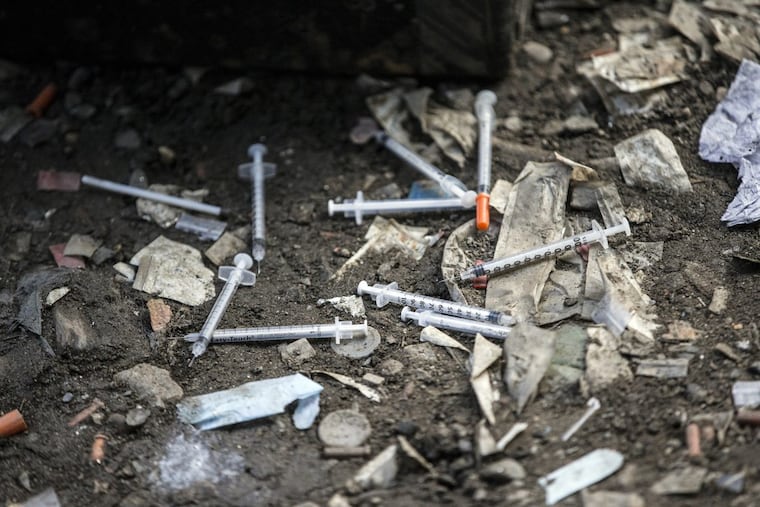Are discarded hypodermic needles a public health threat?
Conrail cleanup is posed to begin, but discarded needles remain a source of concern here and elsewhere.

Cleanup of Philadelphia's infamous heroin gulch along the Conrail tracks in the Kensington and Fairhill neighborhoods is scheduled to start within the next two weeks. The project includes the removal of thousands of hypodermic needles left behind by heroin users, and untold amounts of other debris.
"We've done aerial surveying," said Conrail spokeswoman Jocelyn Hill. She said they expect the entire cleanup to take about a month.
But though Philadelphia's situation is dramatic, it's not unique. In Portland, Maine, officials have collected more than 700 needles so far this year, putting them on track to handily exceed the nearly 900 gathered in all of 2016. In March alone, San Francisco collected more than 13,000 syringes, compared with only about 2,900 the same month in 2016.
People, often children, risk getting stuck by discarded needles, raising fears that they could contract blood-borne diseases such as hepatitis or HIV, or be exposed to remnants of heroin or other drugs.
Joseph D'Orazio, a toxicologist and emergency medicine doctor at Temple University Hospital, said the likelihood of getting infected with HIV or hepatitis C from a needle lying on the ground is "astronomically low."
In addition, he said it's unlikely drug users would discard syringes still containing a significant amount of drugs.
D'Orazio and Ryan Burke, an emergency medicine specialist at Chestnut Hill Hospital, said the much bigger safety risk, especially to children, is opioid medications that youngsters may get their hands on in their homes.
Even a five-milligram pill of an opioid pain reliever is enough to be fatal to a child 2 years old or younger, according to D'Orazio.
It's unclear whether anyone has gotten sick after touching a needle found outside, but reports of children finding the needles can be sickening in their own right.
On July 5, a 9-month-old girl accidentally overdosed after she was stuck in the leg with a hypodermic needle and had to be revived by police with Narcan, the opioid reversal drug. Police said the baby was in bed with her father, Steven Welsh, 35, in his Manayunk home and allegedly rolled onto the syringe. The child was treated at Chestnut Hill Hospital.
In California, a 6-year-old girl mistook a discarded syringe for a thermometer and put it in her mouth; she was unharmed.
"I just want more awareness that this is happening," said Nancy Holmes, whose 11-year-old daughter stepped on a needle in Santa Cruz, Calif., while swimming. "You would hear stories about finding needles at the beach or being poked at the beach. But you think that it wouldn't happen to you. Sure enough."
Even if adults or children don't get sick, they still must endure an unsettling battery of tests to make sure they didn't catch anything. The girl who put a syringe in her mouth wasn't poked, but had to be tested for hepatitis B and C, her mother said.
Discarded needles are something even sanitation professionals exercise caution with. Used needles are supposed to be discarded in hard-sided containers, but not all residents adhere to such precautions. Keisha McCarty-Skelton, city Streets Department spokeswoman, said the agency's residential trash collectors are advised not to handle loose syringes. Hazard pay for city workers who come in contact with refuse such as discarded needles, or who are assigned to cleanup details with such materials, is part of an ongoing discussion, according to city and union spokespeople.
Some experts say the problem will ease only when more users get treatment and more funding is directed to treatment programs.
Others are counting on needle exchange programs, now present in more than 30 states — plus cities, including Philadelphia — or the creation of safe spaces to shoot up, already introduced in Canada and proposed by U.S. state and city officials from New York to Seattle.
Studies have found that needle exchange programs can reduce pollution, said Don Des Jarlais, a researcher at the Icahn School of Medicine at Mount Sinai Hospital in New York.
In Philadelphia, needle exchange operator Prevention Point conducts daily cleanups at neighborhood recreation areas known to be frequented by drug users, such as McPherson Park, said Silvana Mazzella, associate executive director of the organization.
But some also worry that poor supervision at needle exchanges will simply put more syringes in the hands of people who might not dispose of them properly.
After complaints of discarded needles, Santa Cruz County took over its exchange from a nonprofit in 2013 and implemented changes. It did away with mobile exchanges and stopped allowing drug users to get needles without turning in an equal number of used ones, said Jason Hoppin, a spokesman for Santa Cruz County. In Philadelphia, Prevention Point enforces a similar rule, Mazzella said.
This article contains information from the Associated Press.